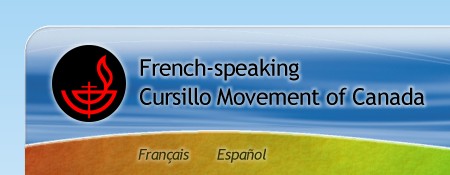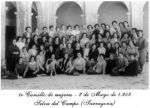
History > 7. A Worldwide Movement
A Worldwide Movement
Youth enthusiasm
 Let’s not forget that when the Movement started, only young men were allowed to live the Cursillo experience. And it was a fantastic success. On the first sixty Cursillos we only know of one (1) who did not convert, at least not openly.
Let’s not forget that when the Movement started, only young men were allowed to live the Cursillo experience. And it was a fantastic success. On the first sixty Cursillos we only know of one (1) who did not convert, at least not openly.
The young men were so enthused that at least twice they waited for Mgr. Hervás to be seated in his car and then they lifted the car at arms length and carried him to his residence.
Cursillos for Women
First: 1952, in Columbia.
In Spain, in 1958, thanks to the tenacity of a friend of Eduardo, Maité
 Cursillos were at first only given to young men, and exceptionnally to men. The first Cursillos for women were given in Columbia, South America as early as 1952, even before they were offered to men! Spain will follow suite, thanks to the exceptional tenacity of a Tarragona woman, personnal friend of Bonnín, Maité. She was intelligent and creative and received her education in England. She started to harass the authorities to also be admitted when her husband lived his Cursillo. She was however refused (for reasons we dare not mention today) and also because some priests thought that "there was nothing in women that needed to be changed!". When a special delegation met with Cardinal Arriba y Castro to ask for Cursillos for women, everyone had cautiously
Cursillos were at first only given to young men, and exceptionnally to men. The first Cursillos for women were given in Columbia, South America as early as 1952, even before they were offered to men! Spain will follow suite, thanks to the exceptional tenacity of a Tarragona woman, personnal friend of Bonnín, Maité. She was intelligent and creative and received her education in England. She started to harass the authorities to also be admitted when her husband lived his Cursillo. She was however refused (for reasons we dare not mention today) and also because some priests thought that "there was nothing in women that needed to be changed!". When a special delegation met with Cardinal Arriba y Castro to ask for Cursillos for women, everyone had cautiously  let the men speak knowing too well the ecclesiastics’ reserve towards women. When finally the cardinal got up to end the meeting, the men having obtained nothing, Maité quickly approached the cardinal, grabbed him by the arm and said: "Eminence, you cannot imagine how unbearable it is to live with a saint and not to be able to share with him!" The cardinal got everyone seated again and the meeting was a success. Some months later, in April of 1958, the first Cursillo for Women was held.
let the men speak knowing too well the ecclesiastics’ reserve towards women. When finally the cardinal got up to end the meeting, the men having obtained nothing, Maité quickly approached the cardinal, grabbed him by the arm and said: "Eminence, you cannot imagine how unbearable it is to live with a saint and not to be able to share with him!" The cardinal got everyone seated again and the meeting was a success. Some months later, in April of 1958, the first Cursillo for Women was held.
Worldwide Freedom of a City
First Worldwide Ultreya, Rome 1966.
Paul VI sanctions the Cursillo Movement
May 1966 saw the First Worldwide Ultreya being celebrated in Rome. The CM was only 17 years old and had already spread over all continents. The Ultreya, according to Father Sebastian Gayá as stated in the minutes he wrote, is a milestone for the CM and he adds: "After the loads of criticisms and misunderstandings we had to suffer, this was the summum of papal sanction". Pope Paul VI’s speech, continually interrupted by cheering, consecrated many of the Movement’s intuitions: "what is fundamental in christianism", "the colors of the grace of God", "meaning of the pilgrimage", "personal encounter with God, and one’s brothers and sisters", etc.
The Worldwide meetings
Confrontation of tendencies and sometimes arduous discussions.
1974 - "Fundamental Ideas of the Cursillo Movement".
 The first one was held in Rome in 1966, with the presence of Pope Paul VI. The second one in Mexico (Tlaxcala), in 1970, was a true meeting of tendencies confrontations and of sometimes arduous discussions. For the first time, the Spanish leaders realized that they no longer held the monopoly of the Movement. In the end, the mexican leaders managed to cool the atmosphere and maintain unity, so a text, which is the first worldwide document of the CM, could be published. It is interesting to read its summary and compare it with what is being lived today, some 30 years later:
The first one was held in Rome in 1966, with the presence of Pope Paul VI. The second one in Mexico (Tlaxcala), in 1970, was a true meeting of tendencies confrontations and of sometimes arduous discussions. For the first time, the Spanish leaders realized that they no longer held the monopoly of the Movement. In the end, the mexican leaders managed to cool the atmosphere and maintain unity, so a text, which is the first worldwide document of the CM, could be published. It is interesting to read its summary and compare it with what is being lived today, some 30 years later:
- Candidates selection by a group and for a group.
- Adaptation of rollos to today’s life and center them on history of salvation
- Towards a greater involvement of priests and laymen in temporal environments
- More individual and collective testimonies
- Openness to the Church’s pastorale
- Give rise to the community spirit in the post-cursillo
- Favoring base communities
- Promoting the presence of women in the CM organisation
- Fortify the family spirituality.
There were tensions in the Mexico meeting, but they were even worse during the third meeting in Mallorca in 1972. The challenge of writing in one week a manual for leaders agreed about by all participants, was far too ambitious. Everyone realized that much more time was required. In fact, it was not until two years later, in 1974, that the first edition of the Fundamental Ideas for the Cursillo Movement came off the press. The credit for putting out the idea of this book and bringing it to fruition goes to the Mallorca meeting.
 The fourth worldwide meeting was not held till much later, in 1988, in Caracas, Venezuela. During that meeting Eduardo had the privilege of meeting with Cardinal Pironio, pontifical delegate, to explain his worries about how the structures were anihilating the mystic of the Movement. The next day, during the solemn entrance of the celebrants in the stadium where 10,000 cursillistas were signing in unisson, cardinal Pironio went to Eduardo saying: "You see, you need not worry: structures have not anihilate the mystic!". The highlight of the Caracas meeting was the work done in the new edition of the "Fundamental Ideas..."
The fourth worldwide meeting was not held till much later, in 1988, in Caracas, Venezuela. During that meeting Eduardo had the privilege of meeting with Cardinal Pironio, pontifical delegate, to explain his worries about how the structures were anihilating the mystic of the Movement. The next day, during the solemn entrance of the celebrants in the stadium where 10,000 cursillistas were signing in unisson, cardinal Pironio went to Eduardo saying: "You see, you need not worry: structures have not anihilate the mystic!". The highlight of the Caracas meeting was the work done in the new edition of the "Fundamental Ideas..."
The last worldwide meeting was held in September of 1997 in Korea.
CONCLUSION
One of the main point of our history is that the Cursillo Movement is a movement of conversion, therefore a missionary Movement. Any diocese which does not attempt to spread the Good News does not live up to the grace of the Movement. Cursillistas are called to carry on to the end, to intensely live their engagement to work for the conversion of their brothers.
For more information
The above Historical Overview is made up of extracts from a 40 page manual written in French "SURVOL HISTORIQUE DU MC - Sa genèse et son expansion, 1944-1999" by Father Loyola Gagné, s.s.s. The document is available at: MCFC Supplies and Products


